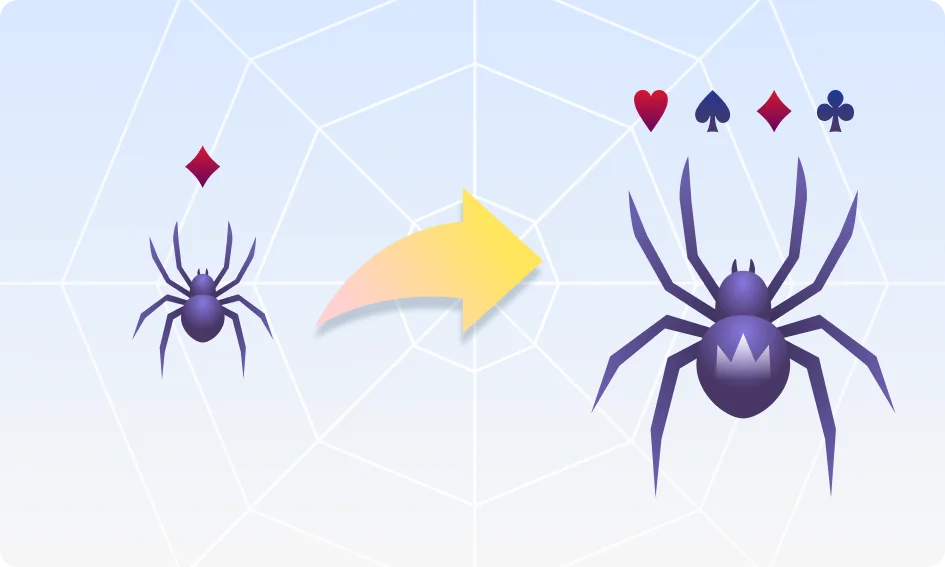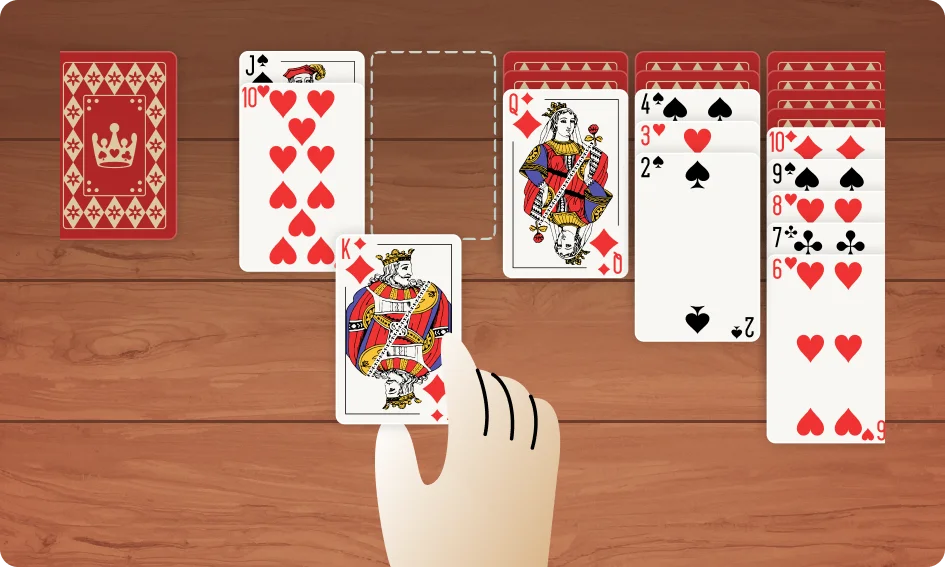Ever since Microsoft Windows popularized digital Solitaire in the early 90s, few Solitaire variants have gained as much love as Spider Solitaire. This can be attributed to the game’s simple layout and easy rules. Every Spider Solitaire player that I’ve met has emphasized how elegant and simple the game is.
This variant was the first to catch my eye when I was looking for a new gameplay experience after spending most of my early teens playing Klondike Solitaire. After quickly reading the rules, I was all set to conquer this supposedly simple variant. The reality of the matter turned out to be quite different.
My first game was a disaster. After playing for an hour, all I could do was stare at the screen. I struggled to find possible moves, and then finally admitted defeat. It was a challenging start, to say the least. I would soon discover that the blame lay entirely at my feet. I was overconfident due to my experience with Klondike and overlooked the fact that this game has three difficulty levels. It turned out that I was playing 4 Suits Spider Solitaire – the most demanding level!
This was a humbling lesson for me. I began to understand the importance of comprehending a game’s intricacies before getting started. In this guide, I’ll chronicle my journey from novice (trying to understand 1 Suit Spider Solitaire) to seasoned player (with a high win rate at the 4 Suits version). All you have to do is follow my suggestions in this blog. Sooner or later, you will be the one teaching 4 Suits to your mates. Trust me, it isn’t as hard as it seems.
How To Play 1 Suit Spider Solitaire
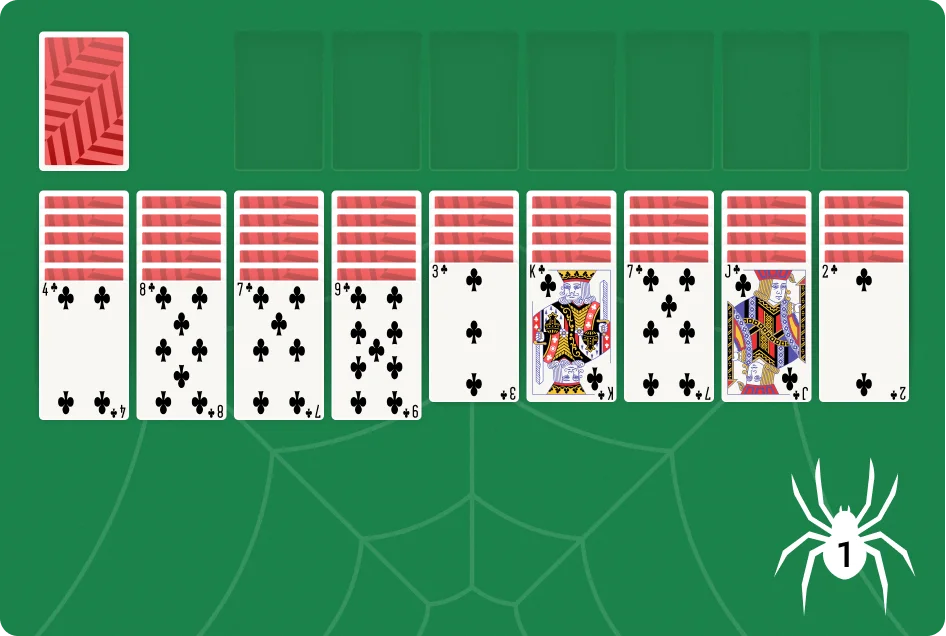
1 Suit is the most fundamental and simple Spider Solitaire variant. It simplifies the deck by eliminating three suits. This transforms all the cards in the deck into a single suit, typically Hearts (although it’s Clubs in the above illustration). You’re required to use two decks for this game, so you’ll be looking at a total of 104 Hearts. If you’re playing physically, then you’ll have to treat all suits as if they’re the same. If you’re playing online, then all the cards in the decks will be automatically transformed into a single.
Now that we know what the cards look like, we can learn how to set up the game and then which rules apply.
Game Setup
- Shuffle the two decks (consisting of all Hearts) together.
- Lay a row of 10 cards face down.
- Add another four rows of face-down cards on top of the first row. Each row must slightly overlap the row beneath it.
- Place an extra face-down card in each of the first four columns.
- Turn over each column’s top card.
- Set aside the remaining deck; this serves as the stock.
Game Rules
- The objective in the game is to create sequences of cards within a column from King down to Ace. Once you complete a sequence, you remove those cards from the game. So, to win the game, you need to complete eight sequences.
- During the gameplay, you can move face-up cards to another card as long as the card you are moving is one rank lower than the card you are placing it on. For example, a 7 of Hearts can only be placed on top of an 8 of Hearts.
- When you move a card, thereby exposing a face-down card, you can turn that face-down card over.
- As the game progresses, you’ll start running out of moves. When you have no more moves to make, you can bring in a new row of cards from the stock. You can place one face-up card on each column.
- When you complete a sequence from King down to Ace, you then remove that sequence from the layout.
- You can also move cards in sequence together as a stack. For example, cards in the sequence 8, 7, 6, and 5 of Hearts can be placed on top of a 9 of Hearts.
- You can move any card or sequence of cards to an empty column.
- When you bring in a new row of cards from the deck, all 10 columns must have at least one card in them.
This should be relatively easy to grasp. 1 Suit Spider Solitaire is the perfect difficulty level for beginners. Even if you have prior experience playing Klondike or FreeCell Solitaire, I recommend that you don’t make my mistake. Start your Spider Solitaire journey with 1 Suit.
How To Play 2 Suits Spider Solitaire
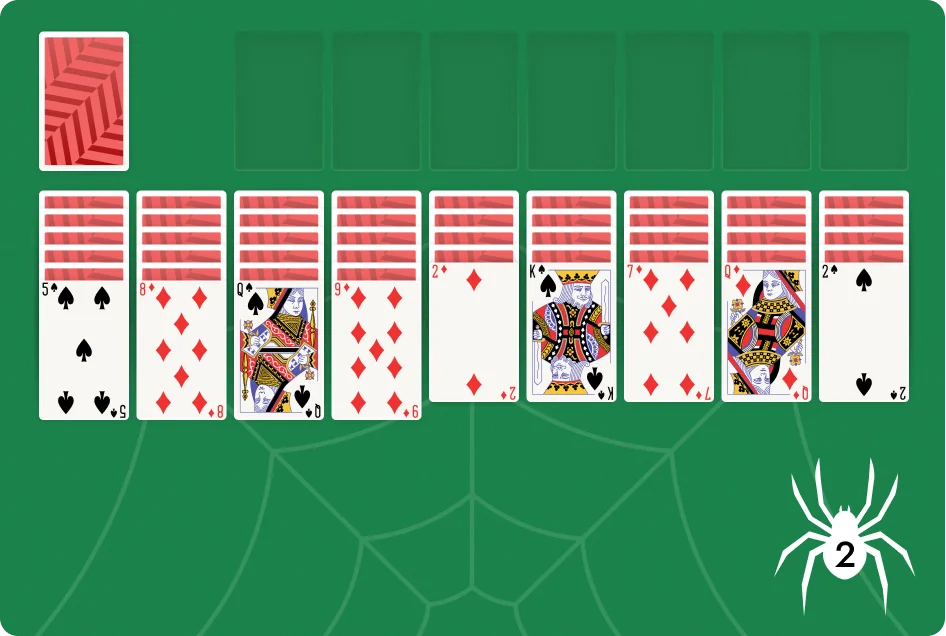
As the name suggests, this variant takes the difficulty one level higher by introducing another suit. The addition of this new suit means you’ll have to pay attention to both a card’s rank and the ‘shape’ it features. This means that, although you can move cards on top of other cards regardless of their suit, you can only remove a King-to-Ace sequence if all the cards in the sequence belong to the same suit.
It should now be clear why I emphasized mastering 1 Suit Spider Solitaire first. The 2 Suits variant has a reputation for really frustrating novice players. When I first graduated from 1 Suit to 2 Suits, my first reaction was to mutter “This is impossible”.
Many players share my reaction. The prospect of keeping card suits in mind is enough to discourage many from abandoning the comfort of 1 Suit. But, those of us who are relentless Solitaire enthusiasts seek out these kinds of challenges.
My experience with this variant spans over five years. During that time, I have learned a couple of excellent tips and tricks. These will speed up your Spider Solitaire journey. Here’s what you need to know:
| Strategy | Details |
| Reserve the stock. | Treat your stock as your very last option. It’s a good idea to first exhaust all possible moves before eyeing the stock for additional cards. |
| Try to kill two birds with one stone. | Try to accomplish multiple objectives with a single move. For example, moving a single card might allow you to turn over a hidden card, create an empty column, and complete a sequence. These types of moves are more abundant than you think. |
| Relocate complete sequences. | If you’ve managed to assemble a full sequence of cards, then don’t hesitate to move it as a whole. Doing so can free up a column or reveal hidden cards. |
| Empty columns are not meant to remain empty. | Empty columns are invaluable resources. You can use them to rearrange cards and build sequences. |
How to Play 4 Suits Spider Solitaire
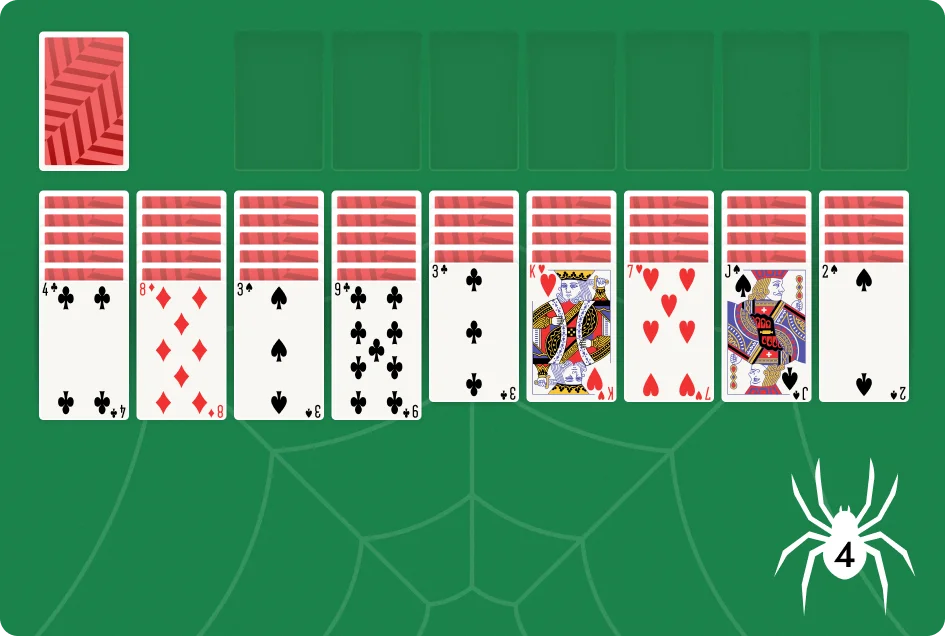
The original version of the game – 4 Suits Spider Solitaire – takes the challenge up by not one but four levels! This variant uses all four suits (Spades, Hearts, Clubs, and Diamonds). It is undoubtedly the most challenging version of the game.
That said, it took me less time to get the hang of 4 Suits than 2 Suits. This was surely because the skills and tactics I learned while playing 2 Suits are scalable to 4 Suits. The only real difference is that the 4 Suits version requires you to unwaveringly employ one of Solitaire’s most fundamental tenets: patience. If you are hasty (even with a single move), then you can bid farewell to the prospects of winning the game.
If you’ve spent hours honing your 2 Suits skills before advancing to the 4 Suits version, then my main advice is to play as many 4 Suits games as possible. That’s it – practice and practice. By repeatedly engaging in this arena, you’ll accustom your brain to learning and predicting all possible moves. It’s almost like developing a sixth sense.
Nonetheless, here are a few handy strategies. You should keep these in mind before tackling the ‘wild horse’ that is 4 Suits Solitaire:
| Strategy | Details |
| Keep an eye out for the column that contains the most hidden cards. | Prioritize columns that have the most concealed cards. These face-down cards can be an ‘oasis in the desert’ when you seem to have exhausted all your moves. |
| Choose order over turning. | At times, prioritize maintaining order over flipping new cards. You don’t want to unnecessarily break up neat sequences just for the sake of uncovering a card, no matter how lucrative that might be in the short term. |
| Don’t be intimidated by disorder. | Seriously, no one is judging you. If you mess up big time, use this button to fix your mistake. As long as you don’t abuse it, it’s crucial to the learning process. |
| Don’t shy away from using the redo button. | Seriously, no one is judging you. If you mess up big time, use the redo button to fix your mistake. As long as you don’t abuse it, it’s crucial to the learning process. |
To summarize, just trust the process and play the game with dedication and commitment. Sooner or later, you’ll be dominating the different Spider variants. That said, remember that 4 Suits is reported to have a win rate of less than 10%. So, you’re obviously not meant to win every single game. It’s mathematically impossible. Try to focus on the learning process, and, most importantly, don’t forget to have fun!
Conclusion
The journey from 1 Suit to 4 Suits Spider Solitaire is not an easy one. That’s exactly what makes it so special. The sense of accomplishment one gains after winning one’s first game playing each version is great. I can’t wait for you fellow Solitaire connoisseurs to experience it as well.

